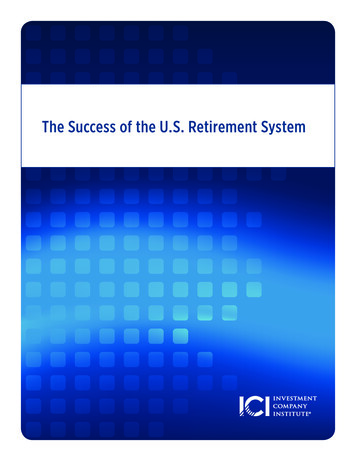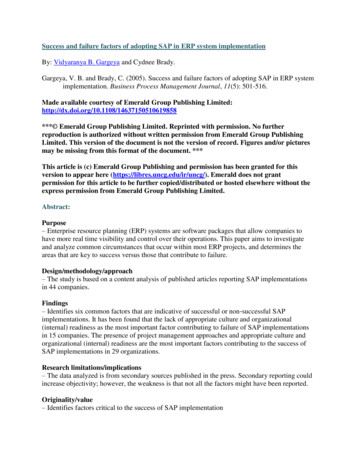
Transcription
The Success of the U.S. Retirement System
Copyright 2012 by the Investment Company Institute. All rights reserved.Suggested citation: Brady, Peter, Kimberly Burham, and Sarah Holden. 2012. The Success of the U.S. RetirementSystem (December). Washington, DC: Investment Company Institute.
The Success of the U.S. Retirement SystemPeter Brady, ICI Senior Economist; Kimberly Burham, ICI Economist; and Sarah Holden, ICI Senior Directorof Retirement and Investor Research, prepared this report.Key Findings. 3Introduction. 4Households’ Savings Goals . 5Focus of Saving Changes over the Life Cycle. 5Focus of Saving Varies with Household Income. 6Using Focus on Retirement Savings to Understand Statistics on Retirement Plan Coverage. 8The U.S. Retirement System: A Retirement Resource Pyramid. 9Evidence of the Success of the U.S. Retirement System . 10Assets Earmarked for Retirement over Time. 10Wealth and Retirement Accumulations of Successive Generations. 12Poverty Among Older Individuals over Time. 14Changes in Households’ Standard of Living at Retirement . 14Changes in Household Wealth in Retirement. 17Components of the U.S. Retirement Resource Pyramid. 17Social Security Benefits. 17Homeownership. 22Employer-Sponsored Retirement Plans and IRAs. 26Other Assets. 32
Estimating the Components of the Retirement Resource Pyramid. 34What Do Current Trends Suggest About Retirement in the Future?. 36Historical Trends in Retiree Income from Employer-Sponsored Retirement Plans and IRAs. 36Projecting the Future of Retiree Income from Employer-Sponsored Retirement Plans and IRAs . 37What Are the Primary Areas of Concern Going Forward?. 39Conclusions. 42Appendix: Additional Detail on Surveys, Housing-Related Data, and Near-Retiree Households. 43Notes. 53References. 572 The SUCCESS OF THE U.S. RETIREMENT SYSTEM
Key Findings»» The U.S. retirement system has successfully provided adequate retirement resources to generationsof Americans. Studies that examine spending, income, and wealth conclude that households, onaverage, maintain their standard of living in retirement. By some measures, retirees appear to bebetter off than other segments of the population: in 2011, a lower percentage of the populationaged 65 or older lived in poverty (9 percent) than the percentage aged 18 to 64 (14 percent) or thepercentage younger than 18 (22 percent).»» To date, successive generations of retirees have been better off than previous generations. Analysisshows that, on average, more-recent generations of households have higher levels of resources todraw on in retirement than previous generations. Other measures also indicate improvements inretiree well-being. For example, the poverty rate among people aged 65 or older has declined fromnearly 30 percent in 1966 to 9 percent in 2011.»» The shift in private-sector retirement plans from predominantly defined benefit (DB) plans topredominantly defined contribution (DC) plans is unlikely to reduce retirement preparedness. Theextent to which previous generations of retired households relied on income generated by privatesector DB plans is often exaggerated. Since 1975, the prevalence of income generated by privatesector retirement plans of all types (measured by both the share of retirees with the income and theamount of income) has increased substantially. In fact, because they are better suited to the mobileU.S. workforce, several studies conclude that the shift from DB plans to DC plans in the privatesector will increase retirement resources for most households.»» The focus of household saving changes over the life cycle. In 2010, only 14 percent of householdsyounger than 35 reported that retirement was their primary savings goal, compared with nearlyhalf of households aged 50 to 64. Younger households typically are focused on other goals:32 percent of households younger than 35 reported that saving for education, homes, or otherlarge purchases was their primary saving goal. Because households may choose to save forretirement when older, it is difficult to assess retirement preparedness for households that arenot in or near retirement.»» Rather than the traditional three-legged stool analogy, a pyramid is a more accurate depiction of theresources Americans rely on in retirement. The retirement resource pyramid has five components:Social Security; homeownership; employer-sponsored retirement plans (DB and DC); IRAs; andother assets. Households do not rely on each resource equally; the composition of the retirementresource pyramid varies across households.»» Social Security benefits provide a broad base of resources for nearly all retirees. Social Security hasevolved into a system that provides substantial retirement resources throughout the income andwealth distribution, and provides the primary retirement resource for workers with low lifetimeearnings. For workers born in the 1940s, Social Security is projected to replace 70 percent ofaverage lifetime earnings for the bottom 20 percent of earners and 29 percent of average lifetimeearnings for the top 20 percent of earners.The SUCCESS OF THE U.S. RETIREMENT SYSTEM 3
»» For many households, the homes they live in represent the second most important retirement resourceafter Social Security. Older households are more likely to own their homes; more likely to owntheir homes without mortgage debt; and, if they still have mortgages, are more likely to have smallmortgages relative to the value of their homes. Retired households typically access this resourcesimply by living in their homes and not paying rent.»» Employer-sponsored retirement plans and IRAs play a complementary role to Social Security benefits,increasing in importance for households for whom Social Security replaces a smaller share of earnings.Nevertheless, employer-sponsored plans and IRAs are an important resource for householdsregardless of income or wealth. In 2010, about 80 percent of near-retiree households had accruedbenefits in retirement plans or IRAs. Nearly half of near-retiree households with income less than 30,000; 71 percent of near-retiree households with income of 30,000 to 54,999; and 94 percentof near-retiree households with income of 55,000 or more had retirement accumulations.IntroductionThis study examines the empirical evidence on the effectiveness of the U.S. retirement system. Theempirical evidence demonstrates that the U.S. retirement system is successful. On average, households areable to maintain their standard of living in retirement. To the extent that there has been a trend in retireewell-being, measures such as income, wealth, and poverty rates show that successive generations of retiredhouseholds have become better off—not worse off—over time. The U.S. retirement system will face manychallenges and—as has always been the case—the future is uncertain. However, changes to private-sectorretirement saving—in particular, the growing importance of employer-sponsored defined contribution(DC) retirement plans and individual retirement accounts (IRAs) —do not represent a major challenge forthe system. To date, the shift to a more account-based system has not been associated with a reduction inthe income of retired households, and there is reason to believe that many households will benefit fromthis shift.The U.S. retirement system has five key components. For retirees as a group, Social Security benefitsrepresent the largest component of retirement resources. For some retirees, homeownership representsthe second most important resource. By owning rather than renting the house that they live in, thesehouseholds do not need to generate as much monthly income in retirement. Employer-sponsoredretirement plans—including both defined benefit (DB) plans and DC plans—and IRAs provide asupplement to Social Security benefits. In fact, for many households, retirement plans and IRAs are morevaluable than either their Social Security benefits or the equity they have in their homes. Although lessimportant on average, retirees also rely on other assets in retirement—assets such as financial holdingsoutside of retirement plans and IRAs, investment real estate, and business investments. The importanceof these five components in providing retirement resources differs from household to household. In theirentirety, these five components have allowed recent generations of retirees, on average, to maintain theirstandard of living in retirement.4 The SUCCESS OF THE U.S. RETIREMENT SYSTEM
The first section of this paper illustrates that saving for retirement is one of many savings goals of U.S.households; moreover, the focus of household saving changes over the life cycle and varies with householdincome. The second section introduces a new way to think about retirement planning in the UnitedStates: the retirement resource pyramid. In the third section, the success of the U.S. retirement system isevaluated using various measures. The sections that follow describe the five key building blocks of the U.S.retirement system, the roles they play, and how those roles have evolved. Estimates of the componentsof the retirement resource pyramid are provided for households approaching retirement to analyze howthe pyramid differs across households nearing retirement. Some insights into what current trends suggestabout the future of retirement are explored, including discussions of the likely impact of the shift amongprivate-sector employers from DB retirement plans to DC retirement plans, and the major risks faced byfuture retirees. A summary of the key results concludes the paper.Households’ Savings GoalsHouseholds have many savings goals and the goals vary across the life cycle and across income groups.In addition to saving for retirement, households save to fund education expenses, to purchase homes, topre-fund other large purchases, or to have cash on hand for emergencies or unexpected needs (liquidity).The Survey of Consumer Finances (SCF) asks households their most important motivation for saving.1In the 2010 SCF, 35 percent of U.S. households listed saving for liquidity as their most important reasonfor saving (Figure 1). In fact, regardless of age or income, liquidity is an important motivation for savingfor a substantial portion of households. Retirement was the next most common reason, with 30 percentof households listing retirement as the primary reason they save.2 Another 23 percent of U.S. householdslisted education, buying homes, or saving for other large purchases as their primary savings goal.Retirement is not the most important reason to save for all households, and it is often not the mostimportant reason to save for any given household in every stage of life. For this reason, it is difficult toassess the adequacy of retirement resources for households other than those near or in retirement.Focus of Saving Changes over the Life CycleAs households approach retirement age, they become more focused on saving for retirement. Forexample, in 2010, only 14 percent of households with a household head younger than 35 saved primarilyfor retirement; 32 percent of these households cited education, homes, or large purchases as the primaryreason they saved (Figure 1). Those numbers are reversed for older households aged 50 to 64: nearly halfof these households reported that retirement was their primary savings goal and only 15 percent reportedthat saving for education, homes, or large purchases was their primary savings goal.The household survey data showing that older households are more focused on retirement saving areconsistent with economic models of life-cycle consumption, which predict that households rationally delaysaving for retirement until later in their working careers when they typically have higher earnings. It isnot that younger households do not save, but rather that they typically save for other reasons. Often thefirst savings priority for a household is to build up a rainy-day fund. In addition, younger, newly formedhouseholds often invest in their future in ways that do not result in the accumulation of financial assets orformal retirement savings. Examples include purchasing a home; purchasing consumer durables such asvehicles, appliances, and furniture; funding education; and raising children. These households may chooseto focus on saving for retirement when older.The SUCCESS OF THE U.S. RETIREMENT SYSTEM 5
Figure 1Households’ Primary Reasons for Saving Vary by AgePercentage of U.S. households by age, 2010Age of head of householdAllhouseholdsYoungerthan 3535 to 4950 to 6465 or olderRetirement3014294824Liquidity (cash on hand, emergencies,unexpected needs)3539353039Education, home, or large purchases2332271519Education8111642Buy own home3931(*)Large purchases1212910178146411Investments12111For the family611536No particular reason11114Cannot or do not save42337100100100100100Primary reason for savingOtherTotal(*) less than 0.5 percentNote: Components may not add to the total because of rounding.Source: Investment Company Institute tabulations of the 2010 Survey of Consumer FinancesFocus of Saving Varies with Household IncomeHouseholds at different income levels also have different primary reasons for saving. Having cash on handin the event of emergency or unexpected need (liquidity) was an important reason to save for all incomeand age groups (Figure 2). However, regardless of their age, households with lower incomes were morelikely to report liquidity as their primary reason for saving. Among households aged 35 to 49 in 2010,34 percent of households with income less than 25,000 indicated that liquidity was their primary savingsgoal, compared with 28 percent of households with income of 100,000 or more (Figure 2, top panel).A similar pattern by income is seen among households aged 50 to 64 (Figure 2, lower panel).Saving for education, homes, or large purchases is more important to households with lower incomes thansaving for retirement. For example, among households aged 35 to 49 in 2010, 36 percent of households withincome less than 25,000 reported that saving for education, homes, or large purchases was their primaryreason for saving, compared with 23 percent of households with income of 100,000 or more (Figure 2,top panel). At all levels of income, older households were less likely to save primarily for these reasons.Among households aged 50 to 64 in 2010, 26 percent of households with income less than 25,000 citedsaving for education, homes, or large purchases as their primary reason to save, compared with 10 percentof households with income of 100,000 or more (Figure 2, lower panel).6 The SUCCESS OF THE U.S. RETIREMENT SYSTEM
Figure 2Households’ Primary Reasons for Saving Vary with Household IncomePrimary reason for savingCannot or do not saveOther (investments, for the family, no particular reason)Liquidity (cash on hand, emergencies, unexpected needs)Education, home, or large purchasesRetirementPercentage of households with household head aged 35 to 49 by household income,* 201078693437361285245328373724233334 50,000 to 74,999 75,000 to 99,9994103523272931151720Less than 25,000 25,000 to 34,999 35,000 to 49,99964429 100,000or moreAllHousehold income*Percentage of households with household head aged 50 to 64 by household income,* 201077332645414314323214144848 35,000 to 49,999 50,000 to 74,9993434Less than 25,000 25,000 to 34,999222231011343015162716065 75,000 to 99,999 100,000or more48AllHousehold income**Total is household income before taxes in 2009.Note: Components may not add to 100 percent because of rounding.Source: Investment Company Institute tabulations of the 2010 Survey of Consumer FinancesThe SUCCESS OF THE U.S. RETIREMENT SYSTEM 7
In contrast to other reasons to save, the focus on saving for retirement increases with household income.For example, among households aged 35 to 49 in 2010, 15 percent of households with income less than 25,000 said retirement was their primary reason for saving, compared with 44 percent of households withincome of 100,000 or more (Figure 2, top panel). Among households aged 50 to 64 in 2010, 27 percentof households with income less than 25,000 indicated retirement was their primary reason for saving,compared with 65 percent of households with income of 100,000 or more (Figure 2, lower panel).One reason lower-income households may be less focused on saving for retirement is that, with limitedresources, they prioritize saving for liquidity. Another reason is that the Social Security benefit formula ishighly progressive and results in benefits that replace a much higher percentage of earnings for workerswith lower lifetime income.3 The result is that—at any given age—lower-income households tend to beless focused on saving to supplement Social Security in retirement.Using Focus on Retirement Savings to Understand Statistics on Retirement Plan CoverageUnderstanding differences between households in their motivation for saving can provide insight intostatistics on employer-sponsored retirement plan coverage. Using Current Population Survey (CPS)data for 2011,4 Brady and Bogdan (2012a) find that 50 percent of private-sector wage and salary workerswere employed by firms that sponsored retirement plans (including both DB and DC plans). However,access to retirement plans is not random. Workers who are part of groups who tend to be more focusedon saving for retirement also are much more likely to work for employers that offer plans. For example,limiting the analysis to full-time, full-year workers aged 30 to 64, access to retirement plans increases to60 percent. If the analysis is narrowed further to the groups of workers most likely to be focused on savingfor retirement—workers aged 30 or older with at least moderate levels of earnings and all but the lowestearning workers aged 45 or older—then 69 percent work for employers that sponsor plans. In addition,some in this group without access to plans at their own employers have access to plans through theirspouses’ employers. Taking into account access through spouses, 74 percent of workers who are likely tobe focused on saving for retirement have access to employer-provided retirement plans, and 93 percentparticipate in the plans offered.Looking at the percentage of all workers who have access to retirement plans at their employers at anysingle point in time understates the share of the population who will reach retirement with work-relatedretirement benefits. Many young workers, low-wage workers, or part-time workers are more concernedwith saving for a rainy day, to purchase homes, or to fund education than they are with saving forretirement. However, young workers do not remain young throughout their working careers, and manylow-wage and part-time workers do not remain low-wage and part-time throughout their careers. Manyworkers who do not have access to employer-sponsored retirement plans today will have access to a plan—either through their own employers or their spouses’ employers—prior to retirement.8 The SUCCESS OF THE U.S. RETIREMENT SYSTEM
The U.S. Retirement System: A Retirement Resource PyramidHouseholds rely on many types of resources in retirement and the role each type plays has changed overtime and varies across households. The traditional analogy is that retirement resources are like a threelegged stool. This analogy implies that everyone should have resources divided equally among SocialSecurity, employer-sponsored pension plans, and private savings. This is not currently, nor has it ever been,an accurate picture of Americans’ retirement resources. A pyramid is a better representation of retirementresources.The retirement resource pyramid has five basic components, which draw from government programs,deferral of compensation until retirement, and other savings. The five components of the retirementresource pyramid are Social Security; homeownership; employer-sponsored retirement plans (bothprivate-sector employer and government employer plans, as well as both DB and DC plans); IRAs(including rollovers); and other assets.At the base of the retirement resource pyramid is Social Security (Figure 3). Social Security covershouseholds across all levels of earnings; however, it replaces the largest portion of average lifetimeearnings for households with low lifetime earnings.A resource available to the vast majority of retired households is the home in which they live (Figure 3).Homeownership increases with age and is high across all income groups among near-retiree households.Households who own homes often have no or low mortgage debt by the time they reach retirement age.Households do not have to sell their homes to benefit from them in retirement; they simply have to livein them. Homeownership is like having an annuity that provides rent, as the home provides a place to livethat otherwise would have to be rented.5The next two layers of the retirement resource pyramid consist of accumulations in employer-sponsoredretirement plans (both private-sector employer and government employer plans, as well as bothDB and DC plans) and IRAs (both contributory and those resulting from rollovers from employersponsored plans) (Figure 3). In 2010, the SCF data show that accrued benefits and asset accumulationsin employer-sponsored retirement plans and IRAs constituted a resource for about 80 percent of nearretiree households. Near-retiree households across all income groups have these retirement benefits, butemployer-sponsored retirement plans and IRAs typically provide a larger share of resources for higherincome households.Finally, at the top of the retirement resource pyramid are other assets that a household may own(Figure 3). These assets can be financial assets—including bank deposits and stocks, bonds, and mutualfunds owned outside of employer-sponsored retirement plans and IRAs; and nonfinancial assets—including business equity, nonresidential property, second homes, vehicles, and consumer durables(long-lived goods such as household appliances and furniture). Assets in this category tend to be ownedmore frequently by higher-income households.The SUCCESS OF THE U.S. RETIREMENT SYSTEM 9
Figure 3Retirement Resource PyramidOther assetsIRAs(including rollovers)Employer-sponsored retirement plansHomeownershipSocial SecuritySource: Investment Company InstituteEvidence of the Success of the U.S. Retirement SystemGenerations of retirees have benefitted from the resources provided to them by the U.S. retirement system,and the empirical evidence demonstrates that, on average, retirement outcomes have improved overtime. The amount of assets earmarked for use during retirement has increased over time and successivegenerations of households have reached retirement with higher levels of wealth, on average, than priorgenerations. Furthermore, poverty rates for people aged 65 or older have fallen over time. In addition,expenditure and income data generally indicate that households are able to maintain their standard ofliving when they retire. Finally, research finds that retirees, on average, maintain sufficient wealth togenerate as much income as they could when first retired.Assets Earmarked for Retirement over TimeThe amount of assets earmarked for retirement has grown, even when adjusted for inf lation and growthin the number of U.S. households.Assets earmarked for retirement include IRAs, DC plans, private-sector DB plans, state and localgovernment pension plans, federal pension plans, and annuities. In mid-2012, total retirement assets stoodat 18.5 trillion (Figure 4, top panel) and accounted for 36 percent of U.S. households’ financial assets.6DC plans and IRAs accounted for 9.8 trillion, or more than half, of total retirement assets. Fueled insignificant part by rollovers from employer-sponsored retirement plans (both DB and DC; both privatesector employer and government employer plans), IRAs represented more than one-quarter of the totalU.S. retirement assets in mid-2012, compared with about 10 percent in 1985. DC plans, which include401(k) plans, 403(b) plans, and 457 plans, also have risen in share over the past two decades, largely theresult of private-sector adoption of 401(k) plans. Despite the decline in private-sector DB plans, such planshad assets of 2.4 trillion in mid-2012, and they continue to pay benefits to retirees.7 Federal, state, andlocal government plans had 4.6 trillion in mid-2012, predominantly in DB plans.810 The SUCCESS OF THE U.S. RETIREMENT SYSTEM
Figure 4Retirement Assets Have Grown over TimeAnnuities1Federal pension plans2State and local government pension plansPrivate DB plansDC plans3IRAsU.S. total retirement market assets, trillions of (nominal) dollars, end-of-period, selected 2.44.54.54.73.44.8 e4.9 e5.1 e2005201020112012:Q214.51.41.12.80.62.30.5 0.119750.419852.37.01.41.51.71.319950.33.6Average retirement assets per U.S. household, constant 2012 dollars, rounded to nearest 100, end-of-period, selected 1,30042,30020112012:Q21Annuities include all fixed and variable annuity reserves at life insurance companies less annuities held by IRAs, 403(b) plans, 457 plans, andprivate pension funds. Some of these annuity reserves represent assets of individuals not specifically for retirement; however, informationto separate out such reserves is not available. Because annuities held in IRAs, 457 plans, and 403(b) plans are netted from the flow of fundsaccounts annuities (life insurance pension fund reserves) figure and reported in their respective categories by ICI, ICI reports a lower annuitiestotal than the flow of funds accounts (see U.S. Federal Reserve Board 2012a).2 Federal pension plans include U.S. Treasury security holdings of the civil service retirement and disability fund, the military retirement fund,the judicial retirement funds, the Railroad Retirement Board, and the foreign service retirement and disability fund. These plans also includesecurities held in the National Railroad Retirement Investment Trust and Federal Employees Retirement System (FERS) Thrift Savings Plan(TSP). Although the TSP is similar to a 401(k) plan, assets held by the TSP are included in federal government retirement assets and are notincluded in the DC plan total. At year-end 2011, the TSP held 298 billion in net assets. For more details regarding the TSP, see Clifton LarsonAllen LLP 2012.3 This category includes 403(b) plans, 457 plans, and private employer-sponsored DC plans (including 401(k) plans).e Data are estimated.Note: Components may not add to the total because of rounding.Sources: Investment Company Institute; U.S. Federal Reserve Board; National Association of Government Defined Contribution Administrators;American Council of Life Insurers; Internal Revenue Service, Statistics of Income Division; U.S. Department of Commerce, U.S. Census Bureau;U.S. Department of Labor, Bureau of Labor Statistics; and U.S. Department of Labor, Employee Benefit Security AdministrationThe SUCCESS OF THE U.S. RETIREMENT SYSTEM 11
Even when adjusted for both inf lation and growth in the number of U.S. households, assets specificallyearmarked for retirement have increased significantly over time. As of June 30, 2012, the average amountof retirement assets per U.S. househol
States: the retirement resource pyramid. In the third section, the success of the U.S. retirement system is evaluated using various measures. The sections that follow describe the five key building blocks of the U.S. retirement system, the roles they play, and how those roles have evolved. Estimates of the components











